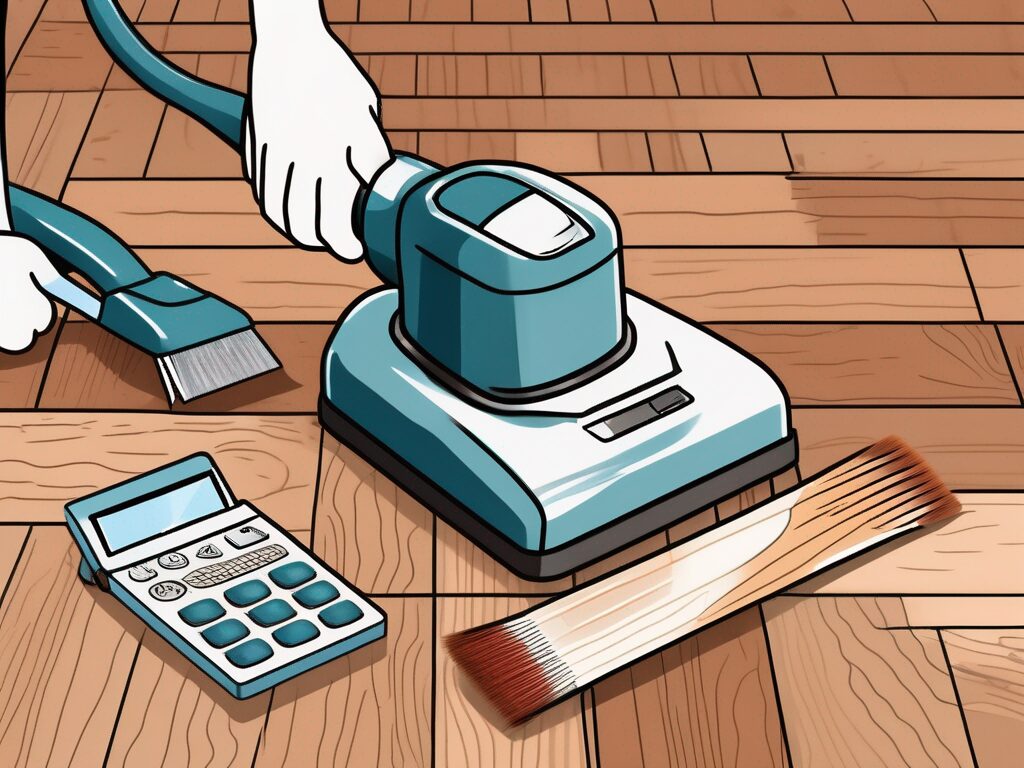
Agent A-Team or Solo Superhero? Finding the Right Real Estate Partner for Your Selling Journey in Wildwood Florida
When it comes to selling your home in Wildwood, Florida,…
January 29, 2024
Are you thinking about refinishing your hardwood floors but not sure how much it will cost? In this ultimate guide, we will help you understand the factors that affect the cost of floor refinishing, break down the costs of materials and labor, provide a real-life cost example, and answer frequently asked questions about hardwood floor refinishing.
Refinishing hardwood floors can breathe new life into your home, but it’s essential to understand the cost involved. Several factors contribute to the overall cost of floor refinishing. Let’s take a closer look at each one.
First and foremost, the size of your floor area is the primary factor that determines the cost. A larger area will require more materials and labor, thus increasing the overall expense. It’s important to measure the square footage accurately to get an estimate that aligns with your budget.
In addition to the size, the condition of your floors plays a significant role in determining the cost of refinishing. Floors with deep scratches or extensive damage may require more time and effort to refinish, leading to higher costs. The extent of repairs needed will be assessed by the flooring contractor during the initial inspection.
Another factor that affects the cost is the type of finish you choose. Different finishes have varying prices, and some may require additional coats for optimal durability. It’s crucial to discuss your preferences and budget with the flooring contractor to find the best finish that suits your needs.
Furthermore, your location can impact the cost of floor refinishing. Labor rates and the availability of materials can vary from one area to another. If you live in a remote location or an area with limited resources, the cost may be higher due to transportation and accessibility challenges.
When calculating the cost of floor refinishing, it’s important to consider both materials and labor. Materials typically include sandpaper, stains, sealers, and finishing products. The cost can vary depending on the quality and brand of the products you choose. Higher-quality materials may come with a higher price tag but can result in a more durable and aesthetically pleasing finish.
Labor costs are another significant factor to consider. Hiring a professional flooring contractor ensures a high-quality finish, but it comes at a price. Labor rates can depend on various factors, such as the contractor’s experience, location, and the complexity of the job. It’s crucial to obtain multiple quotes and compare them to ensure you’re getting a fair price for the services provided.
Keep in mind that more extensive repairs or additional services, such as moving furniture, may incur additional costs. Discuss these details with the flooring contractor beforehand to avoid any surprises when it comes to the final bill.
Understanding the cost of floor refinishing is essential for proper budgeting and decision-making. By considering factors such as the size of your floor area, the condition of your floors, the type of finish, and your location, you can get a clearer picture of the overall cost. Remember to factor in both materials and labor when calculating the expenses, and don’t hesitate to consult with professionals to ensure a successful and cost-effective refinishing project.
Let’s explore a real-life case study to give you a better idea of the cost of floor refinishing. In this scenario, we have a 500 square feet hardwood floor in average condition that requires sanding, staining, and three coats of finish.
The materials needed for this project include sandpaper ($80), stain ($50), sealer ($30), and finish ($60). The total material cost comes to $220.
The labor cost for a project of this size and complexity might be around $800. Therefore, the total cost of this floor refinishing example would be approximately $1,020.
It’s important to note that the cost of floor refinishing can vary greatly depending on various factors, as we’ve discussed. The case study above provides a general estimate, but it’s always recommended to obtain quotes from local contractors to get a more accurate cost for your specific project.
When it comes to floor refinishing, there are several factors that can influence the cost. One of the main factors is the size of the floor. Larger floors will naturally require more materials and labor, resulting in a higher cost. Additionally, the condition of the floor plays a significant role. If the floor is in poor condition, it may require more extensive sanding and repairs, which can increase the overall cost.
Another factor to consider is the type of wood used for the floor. Different types of wood have different characteristics and may require specific treatments or finishes. Some types of wood are more expensive than others, which can impact the cost of refinishing. Additionally, the complexity of the project can affect the cost. For example, if there are intricate patterns or designs on the floor, it may require more time and effort to refinish, resulting in a higher cost.
It’s also worth mentioning that the cost of floor refinishing can vary depending on your location. Prices may differ from one region to another due to variations in labor rates and the availability of materials. Therefore, it’s always a good idea to get quotes from local contractors to get a more accurate estimate for your specific project.
When hiring a contractor for floor refinishing, it’s important to consider their experience and reputation. Look for contractors who have a proven track record in floor refinishing and positive customer reviews. It’s also a good idea to ask for references and examples of their previous work to ensure they can deliver the quality you expect.
In conclusion, while the case study provided above gives a general estimate of the cost of floor refinishing, it’s important to remember that there are several factors that can influence the final cost. By considering factors such as the size of the floor, the condition of the wood, the complexity of the project, and the location, you can get a better understanding of the cost involved. Obtaining quotes from local contractors will provide you with a more accurate estimate for your specific project, ensuring that you can make an informed decision.
Now that you have a better understanding of the cost of floor refinishing, let’s address some frequently asked questions to help you make informed decisions about your hardwood floors.
One common question is whether to refinish or replace hardwood floors. While refinishing can significantly improve the appearance of your floors, there are cases where replacement might be necessary. Factors such as extensive damage, water stains, or an outdated style may warrant replacement over refinishing. Consulting with a professional can help you make the best decision for your specific situation.
When considering whether to refinish or replace your hardwood floors, it’s important to evaluate the overall condition of the wood. Refinishing is a great option if the floors are structurally sound and only require surface-level improvements. However, if there are deep scratches, gouges, or warped boards, replacement may be the better choice. Additionally, if you’re looking to update the style of your floors, replacement allows for more design flexibility.
Some homeowners may be tempted to save money by attempting a DIY floor refinishing project. While it is possible, it’s important to understand the risks and considerations involved. Properly sanding, staining, and finishing hardwood floors requires skill and experience. Mistakes can result in uneven finishes, damaging the wood or even requiring professional intervention to correct the errors. If you decide to tackle the project yourself, make sure to thoroughly research and follow best practices to achieve the desired results.
Before embarking on a DIY floor refinishing project, consider your own level of expertise and the time commitment required. Refinishing floors can be a time-consuming process, especially if you have a large area to cover. Additionally, the equipment needed, such as sanders and buffers, can be expensive to rent or purchase. It’s also important to note that DIY refinishing may void any warranties on your hardwood floors, so be sure to check with the manufacturer before proceeding.
Refinishing your hardwood floors can have a positive impact on the value of your home. Potential buyers often appreciate the beauty and durability of hardwood floors, making your property more attractive. Additionally, well-maintained floors can provide a modern and cohesive aesthetic, enhancing the overall appeal of your home.
When it comes to adding value to your home through hardwood floor refinishing, it’s important to consider the broader real estate market and the preferences of potential buyers in your area. In some markets, hardwood floors are highly sought after and can significantly increase the value of your home. However, in other markets where alternative flooring options are more popular, the impact on value may be less pronounced.
Furthermore, the condition of the rest of your home plays a role in the overall value. Refinished hardwood floors can complement other updates and renovations, creating a cohesive and appealing look throughout your home. However, if the rest of your home is outdated or in need of repair, the impact of refinishing the floors alone may be limited.
Now armed with the knowledge of the factors affecting the cost of floor refinishing, how to calculate the expenses, and the impact on your home’s value, you are well-equipped to make informed decisions about your hardwood floors. Remember to seek professional advice when necessary and carefully consider your options before undertaking any major renovations. Happy refinishing!

If you want the Richr team to help you save thousands on your home just book a call.
 Book a call
Book a call